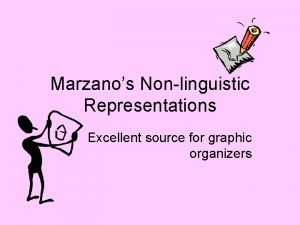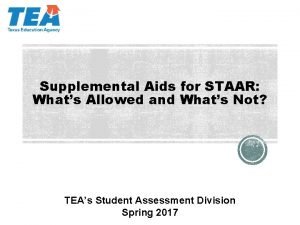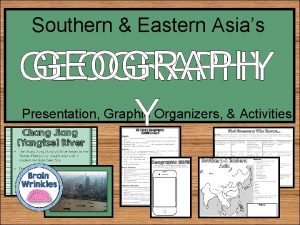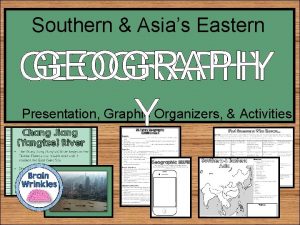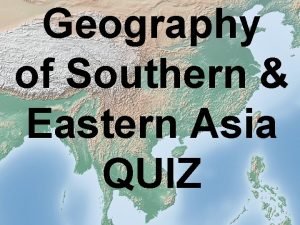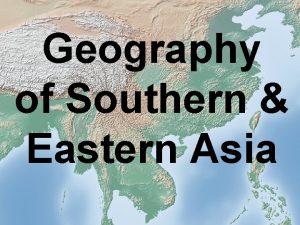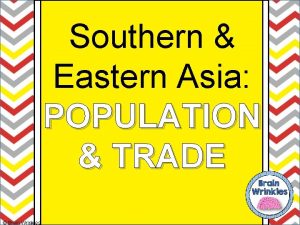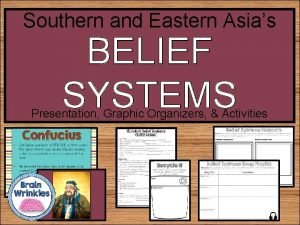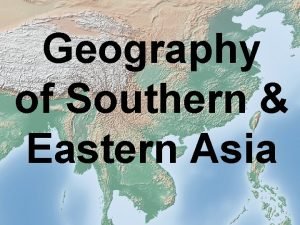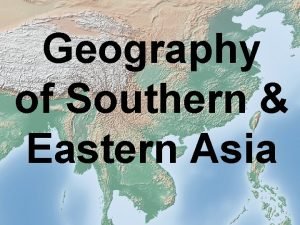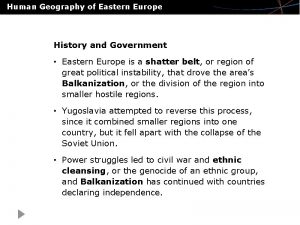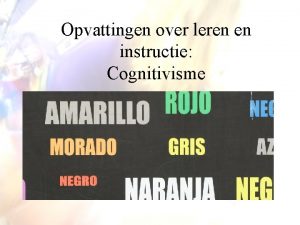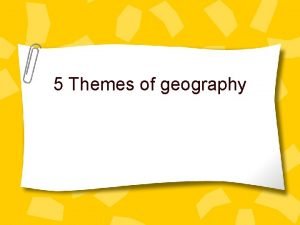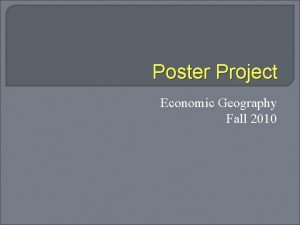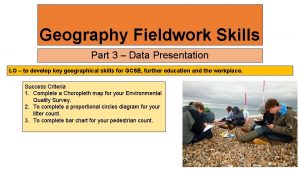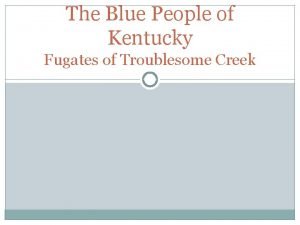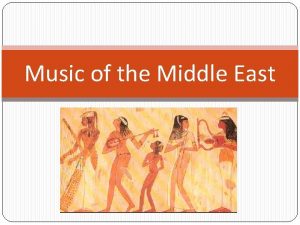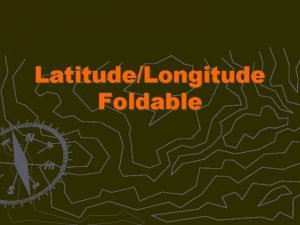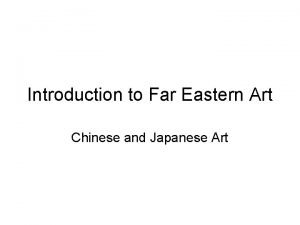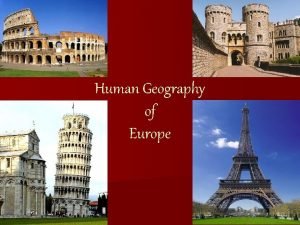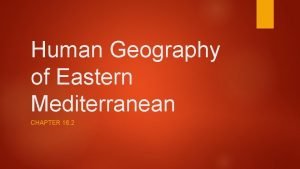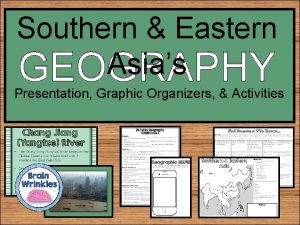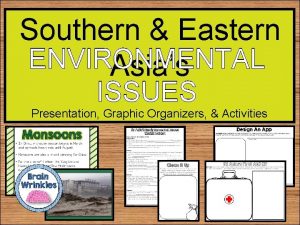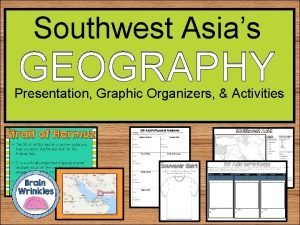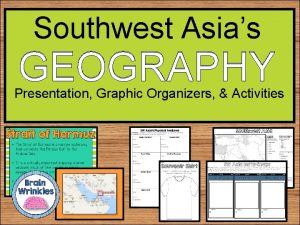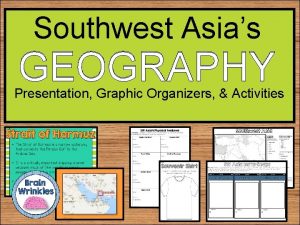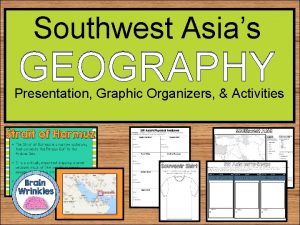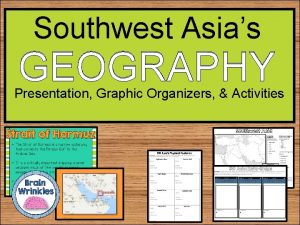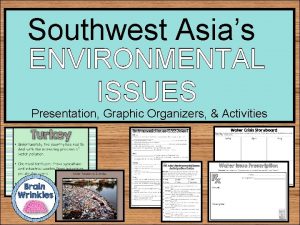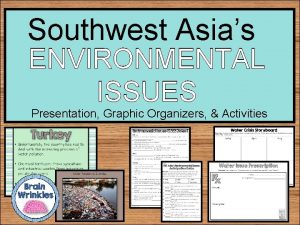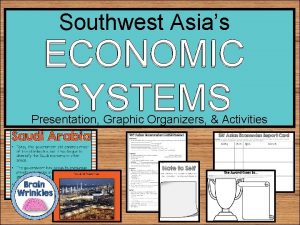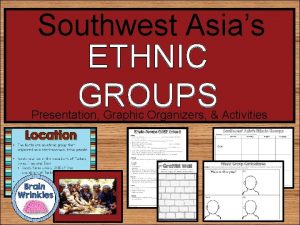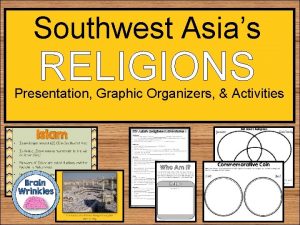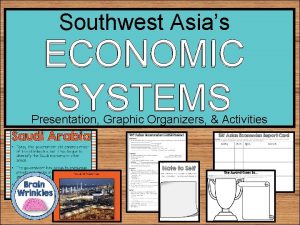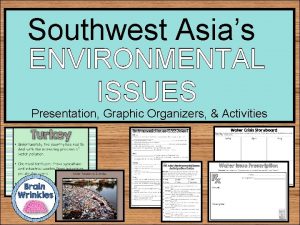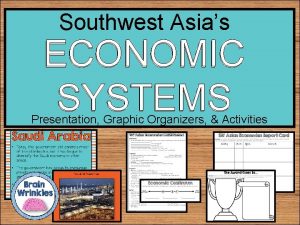Southern Eastern Asias GEOGRAPHY Presentation Graphic Organizers Activities



































































- Slides: 67

Southern & Eastern Asia’s GEOGRAPHY Presentation, Graphic Organizers, & Activities

STANDARDS: SS 7 G 9 Locate selected features in Southern and Eastern Asia. a. Locate on a world and regional political-physical map: Ganges River, Huang He (Yellow River), Chang Jiang (Yangtze) River, Bay of Bengal, Indian Ocean, Sea of Japan, South China Sea, Yellow Sea, Gobi Desert, Taklimakan Desert, Himalayan Mountains, and Korean Peninsula. b. Locate on a world and regional political-physical map the countries of China, India, Japan, North Korea, South Korea, and Vietnam. © Brain Wrinkles

Weekly Agenda: 1 -25 to 1 -29 -21 Weekly Opening: • Journal Writing • Citizenship Word of the Week: de • Current Events Weekly Work Period: • SE Asia’s Political and Physical Map The students will use Power. Point presentation to label political and physical features. • SE Asia’s Geography Cloze Notes 1 -3 The students will use Power. Point presentation to complete the cloze notes. • SE Asia’s Physical Features Chart: The students will complete the chart using the cloze notes.

Weekly Agenda: 1 -25 to 1 -29 -21 Weekly Work Period cont’: • SE Asia Vocabulary Key Activity: The students will use cloze notes to define each of the Physical Features of S. E. Asia. • SE Asia Billboard: You Are Now Entering Activity Students will choose one of SE Asia’s physical features and create a “welcome sign” that visitors will see as they enter the feature’s region. The sign should include key facts about the feature, as well as illustrations. • SE Asia Geographic Selfie Activity Students will “take a selfie” with one of the physical features from the lesson. They will write a brief description of the place to the right of the picture.

Weekly Agenda: 1 -25 to 1 -29 -21 Weekly Closing: • SE Asia Find Someone Who Knows Comprehension Check Students will complete this handout at the end of the lesson. Students will be given the opportunity to share/compare answer with two other students. This will count as a formative assessment! • SE Asia Geographic Selfie Activity Students will “take a selfie” with one of the physical features from the lesson. They will write a brief description of the place to the right of the picture.

Weekly Assessment/Technology Tools: 1 -25 to 1 -29 -21 • SE Asia Find Someone Who Knows Comprehension Check • USA Testprep (graded assignment; class time is given but can be completed at home) • Edpuzzle Videos (graded assignment; class time is given but can be completed at home) • Discovery Education (graded assignment; class time is given but can be completed at home)

SE Asia’s Geography CLOZE Notes 1 Geography • Asia is the ___________ with a total land area of more than 17 million square miles. • More than ___________ live in Southern and Eastern Asia, with over half of that number living in China and India alone. • The continent has a ___________ of physical features, including deserts, peninsulas, and the world’s highest mountains. Ganges River • The Ganges River starts ___________ and flows southeast through India and Bangladesh for more than 1, 500 miles to the Indian Ocean. • The name comes from a Hindu goddess and the river is considered ___________ religion. • It is the most important river to the ___________. • The river runs through India’s most ___________ and densely populated areas. • Because so many people live and work along the Ganges, the water in the river is ___________. Huang He (Yellow River) • The Huang He, or Yellow River, begins in the ___________ of Tibet and flows east to the Yellow Sea. • This is China’s ___________ river. • Chinese ___________ in the central area of this river basin. • The river is named for the ___________ that it carries along its path to the Yellow Sea. • The silt creates rich topsoil for farmers; however, ___________ make the river’s path dangerous. • It’s nickname is “China’s Sorrow” because of the ___________. Chang Jiang (Yangtze) River • The Chang Jiang (Yangtze) River begins in the Tibetan Plateau and ___________ until it reaches the East China Sea. • It’s the ___________ river in China (over 3, 400 miles) and the third-longest in the world. • The Chang Jiang empties into the ___________. • The Chang Jiang is extremely important for China because it provides ___________ , water for irrigation, and transportation for cargo ships. • The Chang Jiang and Huang He Rivers are connected by one of the world’s ___________ systems, the Grand Canal. • Some parts were built over ___________ ago. © Brain Wrinkles

SE Asia’s Geography CLOZE Notes 2 Bay of Bengal • The Bay of Bengal is an extension of the ___________. • The Bay of Bengal ___________ on its west and Myanmar on its east. • ___________ and many other large rivers flow into this bay. Indian Ocean • The Indian Ocean is the ___________ of Earth’s five oceans. • It is located between Africa to the west, ___________ , and Australia to the east. Sea of Japan • The Sea of Japan is a small sea that is bound by Russia to the north, the Korean Peninsula to the west, and ___________. • It is an arm of the Pacific Ocean that lies between the ___________ and Japan. • The sea has large deposits of mineral resources and abundant fish, both of which are important to ___________. South China Sea • The South China sea is located ___________ and the Philippines. • The South China Sea connects the ___________ oceans, so many of the world’s international shipping channels run through it. • There are often ___________ and typhoons in this region. Yellow Sea • The Yellow Sea is an extension of the Pacific Ocean that lies ___________ and the Korean Peninsula. • The Huang He (Yellow River) empties into the ___________. • It becomes the East China Sea south of the ___________. • The Yellow Sea is well-known for its ___________. • Unfortunately, in recent years, many species of ___________ in the Yellow Sea due to overfishing by some countries. © Brain Wrinkles

SE Asia’s Geography CLOZE Notes 3 Gobi Desert • The Gobi Desert is Asia’s ___________. • It expands across southern Mongolia and ___________. • Much of the Gobi Desert is covered with sand ___________ that is exposed by powerful winds blowing across the region. • The Gobi Desert is known as “Shamo”, the Chinese word for ___________. • It can be one of the hottest and also ___________ places on earth. Taklimakan Desert • The Taklimakan Desert lies between two rugged mountain ranges in ___________. • It is over 600 miles in length, making it one of the ___________ in the world. • ___________ cover 85% of its surface. • The Taklimakan Desert receives ___________ annual precipitation. • The plant and animal life in this desert have had to adapt to the ___________ in order to survive. Himalayan Mountains • The Himalayas lie along the ___________ of the Indian subcontinent and the southern border of China. • They form the ___________ between India and China. • The mountains stretch for about ___________. • The Himalayan mountain range is the ___________ mountain region. • It is sometimes called “the roof of the world” because of the ___________. • Nine of the world’s ten ___________ are located here. • ___________, the world’s highest mountain, is part of the Himalayan range. Korean Peninsula • The Korean Peninsula is a mountainous peninsula that juts ___________ in between the Yellow Sea and the Sea of Japan. • Over half of the peninsula is made up of mountains, but there is still plenty of ___________. • Since the end of World War II in 1948, the peninsula has been divided into ___________ : North Korea (communist) and South Korea (democratic). © Brain Wrinkles

Southern & Eastern Asia’s GEOGRAPHY © Brain Wrinkles

Geography • Asia is the world’s largest continent with a total land area of more than 17 million square miles. • More than 4 billion people live in Southern and Eastern Asia, with over half of that number living in China and India alone. • The continent has a wide variety of physical features, including deserts, peninsulas, and the world’s highest © Brain Wrinkles

© Brain Wrinkles

Ganges River • The Ganges River starts in the Himalayas and flows southeast through India and Bangladesh for more than 1, 500 miles to the Indian Ocean. • The name comes from a Hindu goddess and the river is considered sacred to the Hindu religion. • It is the most important river to the Indian subcontinent. © Brain Wrinkles

© Brain Wrinkles

© Brain Wrinkles

Ganges River • The river runs through India’s most fertile farmland densely populated areas. • Because so many people live and work along the Ganges, the water in the river is heavily polluted. © Brain Wrinkles

© Brain Wrinkles

Huang He (Yellow River) • The Huang He, or Yellow River, begins in the mountainous plateau of Tibet and flows east to the Yellow Sea. • This is China’s second-longest river. • Chinese civilization began in the central area of this river basin. © Brain Wrinkles

© Brain Wrinkles

© Brain Wrinkles

Huang He (Yellow River) • The river is named for the muddy yellow silt that it carries along its path to the Yellow Sea. • The silt creates rich topsoil for farmers; however, annual floods make the river’s path dangerous. • It’s nickname is “China’s Sorrow” because of the frequent flooding. © Brain Wrinkles

© Brain Wrinkles

Chang Jiang (Yangtze) River • The Chang Jiang (Yangtze) River begins in the Tibetan Plateau and travels east until it reaches the East China Sea. • It’s the largest and longest river in China (over 3, 400 miles) and the third-longest in the world. • The Chang Jiang empties into the Pacific Ocean. © Brain Wrinkles

© Brain Wrinkles

© Brain Wrinkles

Chang Jiang (Yangtze) River • The Chang Jiang is extremely important for China because it provides hydroelectric power, water for irrigation, and transportation for cargo ships. • The Chang Jiang and Huang He Rivers are connected by one of the world’s oldest canal systems, the Grand Canal. • Some parts were built over 2, 000 years ago. © Brain Wrinkles

© Brain Wrinkles

Bay of Bengal • The Bay of Bengal is an extension of the Indian Ocean. • The Bay of Bengal touches India on its west and Myanmar on its east. • The Ganges and many other large rivers flow into this bay. © Brain Wrinkles

© Brain Wrinkles

© Brain Wrinkles

© Brain Wrinkles

Indian Ocean • The Indian Ocean is the third largest of Earth’s five oceans. • It is located between Africa to the west, Asia to the north, and Australia to the east. © Brain Wrinkles

© Brain Wrinkles

Sea of Japan • The Sea of Japan is a small sea that is bound by Russia to the north, the Korean Peninsula to the west, and Japan to the east. • It is an arm of the Pacific Ocean that lies between the Asian continent and Japan. • The sea has large deposits of mineral resources and abundant fish, both of which are important to Japan’s economy. © Brain Wrinkles

© Brain Wrinkles

© Brain Wrinkles

South China Sea • The South China sea is located between Vietnam and the Philippines. • The South China Sea connects the Pacific and Indian oceans, so many of the world’s international shipping channels run through it. • There are often violent monsoons and typhoons in this region. © Brain Wrinkles

© Brain Wrinkles

© Brain Wrinkles

Yellow Sea • The Yellow Sea is an extension of the Pacific Ocean that lies between China and the Korean Peninsula. • The Huang He (Yellow River) empties into the Yellow Sea. • It becomes the East China Sea south of the Korean Peninsula. © Brain Wrinkles

© Brain Wrinkles

Yellow Sea • The Yellow Sea is well-known for its fishing industry. • Unfortunately, in recent years, many species of fish have declined in the Yellow Sea due to overfishing by some countries. © Brain Wrinkles

© Brain Wrinkles

Gobi Desert • The Gobi Desert is Asia’s largest desert. • It expands across southern Mongolia and northern China. • Much of the Gobi Desert is covered with sand bare rock that is exposed by powerful winds blowing across the region. © Brain Wrinkles

© Brain Wrinkles

© Brain Wrinkles

Gobi Desert • The Gobi Desert is known as “Shamo”, the Chinese word for “sand desert”. • It can be one of the hottest and also one of the coldest places on earth. © Brain Wrinkles

© Brain Wrinkles

Taklimakan Desert • The Taklimakan Desert lies between two rugged mountain ranges in northwestern China. • It is over 600 miles in length, making it one of the longest deserts in the world. • Giant sand dunes cover 85% of its surface. © Brain Wrinkles

© Brain Wrinkles

© Brain Wrinkles

Taklimakan Desert • The Taklimakan Desert receives very little annual precipitation. • The plant and animal life in this desert have had to adapt to the dry environment in order to survive. © Brain Wrinkles

© Brain Wrinkles

Himalayan Mountains • The Himalayas lie along the northern edge of the Indian subcontinent and the southern border of China. • They form the natural border between India and China. • The mountains stretch for about 200 miles. © Brain Wrinkles

© Brain Wrinkles

© Brain Wrinkles

Himalayan Mountains • The Himalayan mountain range is the world’s highest mountain region. • It is sometimes called “the roof of the world” because of the area’s high altitudes. © Brain Wrinkles

© Brain Wrinkles

Himalayan Mountains • Nine of the world’s ten largest peaks are located here. • Mt. Everest, the world’s highest mountain, is part of the Himalayan range. © Brain Wrinkles

© Brain Wrinkles

Korean Peninsula • The Korean Peninsula is a mountainous peninsula that juts out of northeastern China in between the Yellow Sea and the Sea of Japan. • Over half of the peninsula is made up of mountains, but there is still plenty of rich farmland. © Brain Wrinkles

© Brain Wrinkles

Korean Peninsula • Since the end of World War II in 1948, the peninsula has been divided into two countries: North Korea (communist) and South Korea (democratic). © Brain Wrinkles

© Brain Wrinkles

SE Asia’s Geography I HAVE… WHO HAS…? An Interactive Review Game © Brain Wrinkles

Thank You! Thank you so much for downloading this file. I sincerely hope you find it helpful and that your students learn a lot from it! I look forward to reading your feedback in my store. If you like this file, you might want to check out some of my other products that teach social studies topics in creative, engaging, and hands-on ways. Best wishes, Ansley at Brain Wrinkles

Terms of Use © Brain Wrinkles. Your download includes a limited use license from Brain Wrinkles. The purchaser may use the resource for personal classroom use only. The license is not transferable to another person. Other teachers should purchase their own license through my store. This resource is not to be used: • By an entire grade level, school, or district without purchasing the proper number of licenses. For school/district licenses at a discount, please contact me. • As part of a product listed for sale or free by another individual. • On shared databases. • Online in any way other than on password-protected website for student use only. © Copyright Brain Wrinkles. All rights reserved. Permission is granted to copy pages specifically designed for student or teacher use by the original purchaser or licensee. The reproduction of any other part of this product is strictly prohibited. Copying any part of this product and placing it on the Internet in any form (even a personal/classroom website) is strictly forbidden. Doing so makes it possible for an Internet search to make the document available on the Internet, free of charge, and is a violation of the Digital Millennium Copyright Act (DMCA). Thank you, Ansley at Brain Wrinkles Clipart, fonts, & digital papers for this product were purchased from:
 Yellow sea and east china sea
Yellow sea and east china sea Tea supplemental aids
Tea supplemental aids Blank graphic organizers for math staar
Blank graphic organizers for math staar Staar blank graphic organizers
Staar blank graphic organizers Hierarchical graphic organizer
Hierarchical graphic organizer Mcas accommodations
Mcas accommodations Nonlinguistic representations examples
Nonlinguistic representations examples Staar grammar and mechanics rules
Staar grammar and mechanics rules Marzano graphic organizers
Marzano graphic organizers Mcas graphic organizers
Mcas graphic organizers Brain wrinkles southern and eastern asia
Brain wrinkles southern and eastern asia Se asia geography cloze notes 1 answer key
Se asia geography cloze notes 1 answer key Southern and eastern asia physical features answer key
Southern and eastern asia physical features answer key Southern & eastern asia physical features map answer key
Southern & eastern asia physical features map answer key Brain wrinkles southern and eastern asia
Brain wrinkles southern and eastern asia Brain wrinkles southern and eastern asia
Brain wrinkles southern and eastern asia Se asia's belief systems cloze notes 1 answer key
Se asia's belief systems cloze notes 1 answer key Southern and eastern asia physical features answer key
Southern and eastern asia physical features answer key Southern and eastern asia physical features
Southern and eastern asia physical features How do mountains and plains define eastern europe?
How do mountains and plains define eastern europe? Human geography of eastern europe
Human geography of eastern europe Middle eastern geography
Middle eastern geography Southern colonies geography
Southern colonies geography Non sequitur transition
Non sequitur transition Ghost graphic story graphic and wayfinding
Ghost graphic story graphic and wayfinding Cues
Cues Examples of advance organizers
Examples of advance organizers Expository advance organizers examples
Expository advance organizers examples Dear organizers
Dear organizers Discourse analysis and vocabulary
Discourse analysis and vocabulary Cues questions and advance organizers
Cues questions and advance organizers Cues questions and advance organizers
Cues questions and advance organizers Skimming advance organizer
Skimming advance organizer Operating activities vs investing activities
Operating activities vs investing activities Which of these sports are indoor outdoor
Which of these sports are indoor outdoor Support activities and primary activities
Support activities and primary activities Primary activities and secondary activities
Primary activities and secondary activities 5 themes of geography graphic organizer
5 themes of geography graphic organizer Types of tertiary activities
Types of tertiary activities Presentation about leisure time
Presentation about leisure time Frq examples ap human geography
Frq examples ap human geography 5 themes of geography ap human geography
5 themes of geography ap human geography Ap human geography political geography test
Ap human geography political geography test Geography poster presentation
Geography poster presentation Pedestrian count data presentation
Pedestrian count data presentation Brow presentation birth
Brow presentation birth Leopold maneuver
Leopold maneuver Eastern front line ww1
Eastern front line ww1 Eastern star freemason
Eastern star freemason Webdhis eastern cape
Webdhis eastern cape Eastern woodlands landforms
Eastern woodlands landforms What happened after rome fell
What happened after rome fell Blue people of troublesome creek
Blue people of troublesome creek Name that star
Name that star Pompey's eastern settlement
Pompey's eastern settlement Eastern woodlands clothes
Eastern woodlands clothes Aerophone
Aerophone Eastern hemisphere and western hemisphere
Eastern hemisphere and western hemisphere Central eastern italy
Central eastern italy Far eastern art
Far eastern art Ussr control over eastern europe igcse
Ussr control over eastern europe igcse What is considered eastern europe
What is considered eastern europe Chapter 16 eastern mediterranean answers
Chapter 16 eastern mediterranean answers Flights to eastern oregon
Flights to eastern oregon Eastern woodland tribes
Eastern woodland tribes Eastern woodlands shelter
Eastern woodlands shelter Eastern philosophy
Eastern philosophy Eastern kentucky university aviation
Eastern kentucky university aviation






